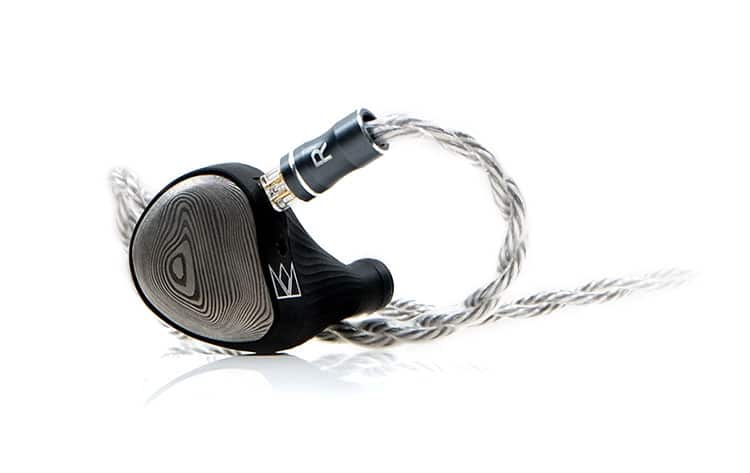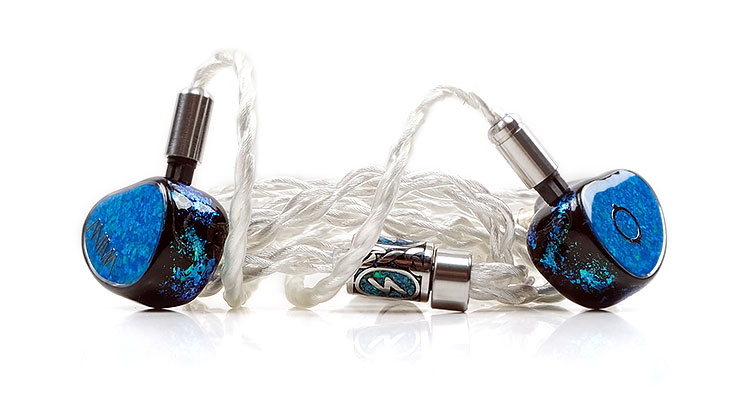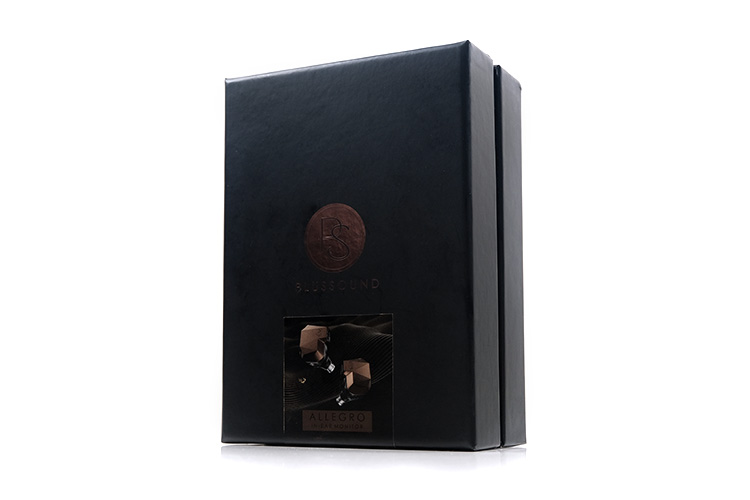Select Comparisons
Noble Audio Viking Ragnar
$4000
The Noble Audio Viking Ragnar is their current flagship universal monitor and our Top Gear 2022 Universal IEM award winner. You can read our full review of the Ragnar here from last year.
Technical
Like the Allegro, the Ragnar is also a blend of three different types of drivers including dynamic, BA, and EST. The precise count differs, with the Ragnar using 10 drivers per side as opposed to 12, however, driver counts are fairly redundant in terms of final output quality these days.
The precise grouping for the Ragnar is also a dual dynamic for the lows like the Allegro, but a dual BA for the mids and a dual BA for the mid-highs or 4 in total compared to 6 for the Allegro split into 2 per grouping, mid-low, mid, and mid-high.
Both monitors use a similar tweeter implementation for their final driver grouping which consists of a quad-EST array and most likely Sonion drivers for the ultra-highs.
The Ragnar crossover is a little bit less complex at 4-way, the lower driver count and split will account for that compared to PLUSSOUND’s more complex 6-way crossover.
The Ragnar is a rare beast in Noble’s lineup as we do have a declared efficiency spec at 17Ω impedance and 112 dB @1kHz. The Allegro seems to be more or less on par at 10Ω for impedance and a similar SPL of 112 dB @1kHz.
In our real-world testing, using the HiBy RS8 on a Turbo Mode low gain balanced 4.4mm output setting, I felt the paper stats were broadly accurate. There are a few tuning differences that make you want to push up the volume of the Allegro, but otherwise, they are almost volume-matched in terms of sensitivity.
Design
These are two monitors that offer an incredible level of design quality. Both use aluminum alloys as their main material but with some very interesting additional qualities, particularly on the plating.
The Ragnar is an evolution of the Sultan format with a relatively large form factor and a three-part build but for my money a step up in the finishing.
It uses a ribbed 2-piece uniform aesthetic for the black anodized main shell, with rune motifs on the sides, and Damascus stainless steel for the plates. The rings on the plate are a natural product of the steel forging process.
The Allegro has a very different but no less intricate styling with a 3-piece dark bronze polygonal faceplate and gloss black diamond pattern body finish.
The body is fashioned from 7-Axis CNC-machined aluminum so the intricacy of the edging is more complex than the Ragnar but perhaps visually more subtle and one that requires a close-up to see just how well made they are.
The Viking is both lighter and volumetrically smaller than the Allegro. It also has a much longer nozzle so tip fitting and overall comfort levels are slightly better with the Ragnar. The level of passive isolation between the two will vary depending on the tips but they are not too far off each other.
The Allegro Copper+ cable is a big advantage though the supplied Ragnar Magnus cable is actually quite competitive with a softer build. It’s more the styling and general dynamic performance of the Copper+ for me that had the edge.
Whereas the silvery tone of the Viking Magnus cable has a very high contrast to the shell designs but does well on teasing out a plump bass on the Ragnar.
Performance
The Allegro, especially with the foam tips, offers a slightly warmer timbre compared to the more neutral coloration of the Viking Ragnar.
Its frequency response has less of a mid-bass to lower-mids scoop whereas the Ragnar focuses more on the sub-bass to mids separation which explains why you might hear a more dominant low-end rumble on the Ragnar and the warmer mid-bass tone from the Allegro.
The Allegro vocals image further forward bringing the staging closer in the process. Both do wonderfully well in producing a balanced vocal tone but the coloring is a little cooler on the Ragnar with its imaging further back relative to your own perceived position.
This creates more perceived space compared to Allegro’s more intimate mids. I still think the Allegro sounds expansive but just not quite to the level of the Ragnar in terms of sheer width.
Treble density and presence are stronger on the Ragnar. The Allegro actually extends equally as well but it’s a little thinner in body with reduced lower-treble presence to flesh out that peppy upper-treble overtone.
Tips will affect both and for me, the Final E tips on the Ragnar do wonderfully well if you want to emphasize the impact of the sub-bass notes when paired with setups such as the P+ mode on the Cayin N8ii and the Turbo Mode from the RS8.
The Allegro still retains a warmer mid-bass, even with silicone tips but when you switch to the foams the mids and treble take on a smoother delivery compared to the Ragnar. I find the silicone tips with the Allegro produce a brighter but leaner treble response compared to the Ragnar which in turn thins out the mids to upper mids timbre also.
Empire Ears Odin
$3399
The Empire Ears Odin is still the company’s flagship universal IEM and our Top Gear 2020 Universal IEM award winner. You can read our full review of the EE Odin here.
Technical
Another triple-driver combination, Much like the Allegro, the Odin uses a mix of dynamic, BA, and EST drivers. The headcount is not too far off each other either at 11 drivers per side inside the Odin and 12 inside the Allegro.
The precise grouping is slightly different and I suspect the precise drivers being used are also quite different. The Odin uses a dual W9+ 9mm dynamic subwoofer driver setup for the lows, 5 balanced armatures with 2 dual-driver units for the lower mids and the mids, and a single BA driver for the mid-highs.
The Allegro is quite similar with a dual dynamic of the lows though I am pretty sure these are not the same type of dynamic drivers and they are 10mm instead of 9mm. It also uses an additional driver for the mid-highs though the general BA split is the same.
Both monitors offer a quad-EST driver array for the highs and both use very complex crossovers with a 6-way for the Allegro and an 8-way for the Odin.
The Odin is rated at just 3Ω impedance so lower than the Allegro, which is listed as 10Ω. On paper, it also has a lower efficiency rating of 103 dB @1kHz compared to 112 dB @1kHz. Both are easy to drive, even with low gain.
However, using the P+ mode of the Cayin N8ii in a low gain balanced output setting, it was the Allegro that sounded the quieter of the two at matched volume. Granted, the Odin has a more aggressive tuning but even so a few dB for the Allegro was still required to get it to a similar level.
Design
It is resin versus metal, heavy versus light, robust versus ‘handle with care’. I mean both have unique design languages but the handling, wearing experience, and how they appeal to your eye are very different.
The Odin’s resin black shell and Bifrost plate have plenty of colored pop and were fantastic when it first came out but a lot of companies have drawn from that since 2020 to roll out similar versions.
The Allegro is the only IEM from PLUSSOUND and its looks are 100% unique with a finishing and quality of material a grade higher with its use of CNC-machined aluminum. No question the Allegro stands out for design intricacy.
However, the Odin has the comfort factor and sits beautifully in the ear with those Final E tips. Resin always gives you a light feel in the ear if done correctly and size-wise it is the smaller of the two IEMs. The Allegro is a tougher match for ear tips and getting the seal right since it is heavier in the ear with a shorter nozzle.
What the Odin lacks is the robustness of the Allegro though you still would want to baby those beautiful, contoured bronze copper plates when out and about.
For cables, this is a tie for me. The Odin Stormbreaker is a modified 2-wire 1960s from PW Audio and it’s a very credible performer in its own right. It’s light, low on microphonics, and has very low memory retention with excellent dynamics when paired.
The Allegro Copper+ is just as good on the performance side, looks stunning also, but offers a slightly smoother richer performance but it is slightly bulkier and stiffer for handling properties.
Performance
Lots of differences between these two monitors. The Allegro is a bit warmer through the bass and mids, with decreased upper-mids and lower treble energy but with an improved upper treble extension.
The Odin elevates the sub-bass extension and presence to another dimension, to be honest, it rumbles hard, especially with the Final E tips. It is vocal and upper mids percussion imaging is very much to the fore with no real perceived 3-5k dip so it picks up on a healthy amount of upper-order harmonics giving its timbre more of a vivid level of contrast.
The Allegro increases the mid-bass to the lower-mid presence and sounds less scooped out meaning mid-bass presence is stronger and warmth travels up a bit more giving instruments an improved body and a more natural level of texture. It’s less contrasty in the mids timbre with a vocal positioning that is forward but not as forward as the Odin.
Treble is mixed for both. Allegro has the better upper treble extension but Odin has more upper-mids to lower treble energy. You get a more delicate but intricate sparkling overtone from the Allegro but a leaner sound at the same time.
Staging is more skewed on the Odin with a strong depth and extension but a pinna gain region that is front and center. Lower-mid instruments are light in their presence and tucked in behind so not the best for classic rock standards.
The Allegro is smoother in its delivery, with slightly less air in the 4-5k region but lower-mid instruments have a better focus. Some will also argue that the Allegro vocals are less fatiguing depending on their preferences.
Lime Ears Anima
€3400
The Lime Ears Anima is their flagship universal IEM from their current lineup. We gave it some high praise when we reviewed it in early 2022 and you can read up in more detail on the Anima here.
Technical
Our final comparison is another tribrid universal IEM and again, a mix of EST, titanium-diaphragm dynamic, and BA. The Anima offers 13 drivers per side as opposed to 12 but this time only a smaller 7mm single dynamic driver for the sub-bass region as opposed to the dual 10mm inside the Allegro.
Just to be clear though that 7mm is only focusing on the sub-bass up to 40Hz and not the complete bass frequency range which is what the Allegro dual 10mm covers. You actually get a dual BA combo for 40-120Hz and another 2 BA around 100-300Hz for the rest of the range.
That leaves 4 BA for the mids split two and two with the first grouping covering the lower mids to the mids and the second two covering the mid-highs. Allegro has put 6 BA into the same region so the individual BA is a little more focused on separating the lower mids, mids, and mid-highs.
Both have quad-EST arrays for the ultra-highs and both use Sonion drivers for this grouping. Both monitors also use a complex 6-way crossover though the phasing is quite different on the Anima since it uses a mix of DD and BA for the bass response.
The Anima is rated at 16Ω and 116 dB @1kHz with the Allegro rated just a little less for impedance at 10Ω and the less sensitive of the two on paper at 112 dB @1kHz. However, testing it with the HiBy RS8 Turbo mode in a low gain balanced 4.4mm setup, I found the Allegro to be somewhat more sensitive with a more energetic performance at lower volume levels.
Design
The Anima has a completely different vibe from the darker bronze and black of the Allegro. It’s a curvy form factor with an aquatic-themed mesh of blue, green, and black in a single continuous-looking theme.
The plate is Bello Opal which is a lab-grown opal material with a very unique mix of matching blue/green colors inside a slim silver bezel and matching logo designs. This is a bright high-contrasting design and is hard to miss.
The Allegro is a darker theme, more executive for me, and in keeping with a lot of the colors PLUSSOUND like to work with on their cables.
The machining is actually far more complex with a denser heavier aluminum construct but with that black shell, it will not stand out quite as much. It is only when you inspect up close do you see the excellent detail on the shells of the Allegro.
The Anima resin is the more fragile but the lighter of the two. Its longer nozzle has the edge for comfort. I would say the Anima tip comfort and pairing for passive isolation are also slightly superior.
However, tip matching is more ‘dangerous’ on the Anima due to its complex nozzle bore design. Basically, different tips can make a great sound like SpinFits, or kill it like the Symbio tips. You do not get that issue with the Allegro.
The Anima uses a Viking Weave and Khanyayo custom-designed cable that’s more traditional in handling, and not quite as stiff as Copper+ wire due to different geometries. It has some beautiful finishing with those matching crushed below particles in the splitter but for me, the Copper+ rose-gold and black option blends in a lot more with the Allegro shells.
Performance
Both the Allegro and the Anima veer more to the warmish side of things but with differences in timbre and emphasis.
The differences lie mainly in the amount of bass scoop each has post 50Hz to 100Hz, just how forward the 1-3k pinna gain area is, and the quantity of upper mids and treble elevation beyond 3k.
Overall, the Allegro has a slightly better balance through the curve for me if your preference is for rock standards, heavy metal, and emo-style indie genres. The Anima veers more to EDM and R’n’B for me simply because of the tendency of those genres to place a higher emphasis on sub-bass synth and overlapping strong vocals.
The Allegro gets that nod for rock and indie because of the gentler dip from its stronger mid-bass down to the lower mids. You get more presence there and better instrumental imaging.
The Anima has a stronger dip starting around 50-80Hz down to 300-400Hz. Instruments across that region pull from healthy sub-bass for a good fundamental but when not called on it’s not as energetic or as full sounding as the Allegro.
The Anima is going for more of an Odin approach to the mids but just a shade more relaxed right at its peak of 2-3k. It’s more forward than the Allegro and whilst both have a normal 4-5k dip the Anima stays fairly reserved with just a narrow peak around 8k.
The Allegro is more elevated from 5-10k and you can hear that in the treble energy and clarity. The Anima treble tuning is not as airy through the lower treble though its shimmer and headroom are good. That leaves the forward mids and upper mids a bit more rounded in tone with less contrast compared to the Allegro mids.
Our Verdict
The PLUSSOUND Allegro looks beautiful on the outside but more importantly, it has the chops sonically to appeal to a wide range of audiophile listening tastes.
I am an old-school rocker at heart so this tuning fits the bill perfectly with a punchy low-end, excellent mids presence for guitar workouts, and enough treble presence to keep those crashing cymbals vivid and exciting sounding.
Play around with the tips and if you have the chance demo with the other cables because they can change the tuning substantially. My personal preference was the foams with the Hybrid+ cable but the stock Copper+ could well have the widest appeal given its non-fatiguing smooth performance.
Well, this surprised me. No messing about from PLUSSOUND, straight to the top table of in-ear monitor performers on the first attempt.
PLUSSOUND Allegro Specifications
- Driver Count / Twelve per side
- Driver Design / Tri-Hybrid (Dynamic, Balanced, EST)
- Drivers Used / Two 10mm Dynamic Drivers (for Low and Sub Low frequencies), Six Balanced Armatures (for Mid-Low, Mid, and Mid-High frequencies), Four Electrostatic Drivers (for High and Super High frequencies)
- Crossover / 6-Way Network
- Driver Organization / 3D Printed Acoustic Chamber
- Outer / Polished, Anodized, cryogenically treated aluminum faceplate, body, and nozzle
- Connector / In-House designed cryogenically treated 0.78mm rhodium plated tellurium copper 2-pin with PEEK insulation
- Internal Wiring / Copper XS (In-house designed cryogenically treated Type 6 UP-OCC with proprietary PS Insulation)
- Impedance / 10 ohms @1kHz @1mW
- Sensitivity / 112 dB @1kHz
- Frequency Response / 10hz – 40kHz
- Allegro Cable / In-house handcrafted cables using custom UP-OCC Litz wires and in-house designed materials, including connectors, splitter, slider, and connector ends.






